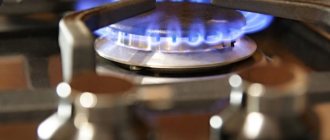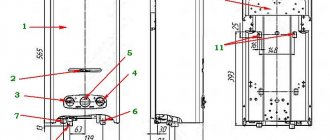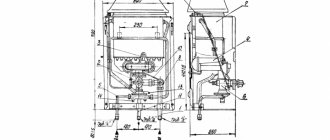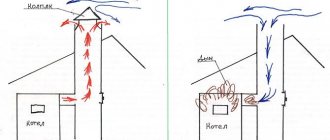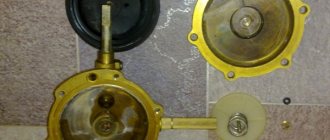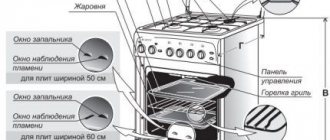A gas water heater is a necessary device in any apartment. It doesn’t need much time to heat the water and does the job very quickly. First of all, you need to remember that a geyser, like any device with gas, is a high-risk device. It ensures the supply of hot water to the house as a result of gas combustion.
After installation, you need to know how to properly start the gas water heater.
How does a gas water heater work?
Any user must understand how a gas water heater works. This is necessary for correct and safe use.
The speaker contains a metal casing, as well as:
The device can be installed both in the kitchen and in any non-residential premises with a ceiling height of at least two meters. In addition, the ventilation in the room must work properly.
Important! It is prohibited to place a gas water heater above the stove.
Gas devices of the Beretta, Electrolux and Neva brands operate in the same way:
- When turned on, water enters the system;
- Due to pressure, the membrane stretches and opens the gas supply valve;
- The burner is ignited, which begins to heat the liquid circulating through the heat exchanger;
- Combustion products are removed through the chimney and ventilation.
There is an opinion that installing a geyser is unsafe. This was during the time of using a device with manual ignition. Currently, the devices have sensors that control water heating and draft in order to prevent an emergency. However, do not forget about safety rules.
If you notice the smell of gas in your apartment, you must:
- Close the gas supply valve;
- Open window;
- Do not turn on electrical devices until the room no longer smells of gas;
- Contact the gas service.
The principle of operation of the technology
It is easier to remember the rules for using the device when you understand its structure. Regardless of the manufacturer, all geysers - Neva, Astra and others - have the same design. Only the location of the nodes can change.
Main nodes:
- Heat exchanger;
- Manifold for gas removal;
- Ignition unit;
- Burner;
- Water and gas fittings.
The column lining is made in the form of a metal casing; in some models it has an inspection window. The panel contains power and temperature regulators. Electronic control is complemented by a display.
Ignition block. Depending on the type of ignition, the product has a piezo ignition button or electronic battery switch.
- Semi-automatic models. Piezo ignition can be triggered in different ways. In some cases, you need to hold the button and press the power control. The wick will burn until you turn off the device yourself. It is recommended to turn off the burner after use or when leaving home. This way you can save gas and extend the life of the device.
- Automatic equipment is more expensive, but is economical to operate. The wick does not burn continuously. The burner lights up only when the mixer is opened and goes out when closed. The electric charge is sent by batteries or a turbine. The batteries need to be changed periodically, and for normal operation of the turbine it is necessary to ensure stable pressure in the line.
Electronic devices may be equipped with a flame regulator. With reduced pressure, the modulator allows you to adjust the heating power so as to obtain the desired water heating temperature.
Manifold with outlet pipe. Located at the top. Pipes are connected to the pipe to discharge combustion products to the street. In devices with a closed combustion chamber, the manifold is located at the bottom and is equipped with a fan for forced removal of fumes. These are turbocharged models such as “Neva Turbo”, “Neva Lux 8224”, Bosch WTD.
Columns of the Astra and Oasis trademarks are produced only with an open combustion chamber.
The heat exchanger (radiator) is the main part in the water heater. Water flows through its tubes, which is heated by a burner. A high-quality radiator is made from pure copper. If impurities are added to the alloy, the assembly quickly burns out and leaks. Read the article “Heat exchanger for a geyser” to learn more about its design.
The burner is located under the radiator. A reliable housing must be made of steel. The part distributes the flame among the nozzles to uniformly heat the heat exchanger.
The gas unit may be located on top of the water unit (in older models) or to the right of it. Operation is regulated by turning the gas on and off.
The water block is located nearby, thanks to which fuel enters the system. When water is turned on, pressure is created in the system, causing the rubber membrane to bend. It pushes out a rod that turns the fuel valve.
An ignition device is located near the burner. The equipment is also equipped with protection sensors:
- The draft sensor monitors the presence of draft in the system;
- Ionization sensor - control of the presence of flame;
- Thermostat - temperature measurement, protection against overheating above 90 degrees.
When one of the sensors is triggered, the device turns off.
Electrical diagram of the device:
Terms of use
If the column is open type, then you should adhere to the following recommendations:
- When installing the speaker, you should take care of ventilation;
- It is strictly forbidden to turn on the device if there is no draft in the chimney;
- There is no need to leave the device on if no one is at home;
- You cannot change the design yourself;
- There is no need to leave the valve open if the burner is not lit.
Important! Only a professional can reinstall a geyser.
Safety requirements
If you smell mercaptan, you should absolutely not light the column. Do not leave the valve open if the burner is not lit. When the chimney works normally, but there is no draft, there is a weakness in natural ventilation in the room. This is usually associated with the installation of blind plastic or aluminum windows. The problem is solved by installing a vent valve.
How to check traction
This refers to open-type geysers. Advanced models include an automatic security system. If the traction disappears during use of the device or is completely absent, then it will not work.
However, you should not rely unconditionally on automatic systems. You need to be able to check for traction. For this purpose, gas service specialists have special measuring instruments that check the force of air movement.
The following methods are used for self-checking:
- Remove the part of the device that is on the left. Place a small strip of paper near the chimney. If there is air movement, the paper will be slightly sucked in.
- Light a match and place your hand next to the viewing window. It is located on the front panel. If the flame is sucked in, then there is draft.
Important! There are cases when everything is fine with the chimney, but there is no draft. This is due to the lack of air flow into the kitchen. To check serviceability, the doors and windows in the room are closed.
Briefly about the main thing
Before lighting a gas water heater, be sure to check the draft in the ventilation system. A burning match is inserted into the viewing window of the burner. Under normal conditions, the flame begins to fluctuate. This procedure can be avoided if modern gas water heaters are used. The sensors built into them simply will not allow the burner to ignite if there is no draft in the system.
The process of igniting the unit itself is quite simple. Either an open flame is brought to the igniter, or you need to use the built-in piezoelectric element. There are modern devices in which the entire ignition process is fully automated. And human actions are reduced to only pressing a button on the dashboard once.
Ratings 0
How to ignite the device
After the device has been installed, the gas water heater is started for the first time. First of all, open the water and gas supply taps. Then, the column is turned on, presented in three ways.
Manually
This method was used in older type columns. You can start the gas water heater only with matches. Fireplace matches are considered the best option for ignition.
In this case, the following actions are performed:
- Open the tap on the water pipe related to the column;
- Turn the gas supply valve;
- The wick is lit with matches;
- The fuel supply valve is turned and the water temperature is adjusted using a special lever.
Reference! The device cannot be turned off until the tap is closed manually.
It is not difficult to light an old gas water heater. Switching off is done exactly the opposite. First of all, you need to turn off the wick, turn off the gas, and then turn off the water.
It is worth working with the old type samples very carefully. Otherwise, an explosion, device failure, or gas leak will occur.
Using piezo ignition
A semi-automatic device with no batteries, having mechanical switches in the form of handles. To ignite it, you need to get a spark.
The following manipulations are performed:
- Open the fuel transfer;
- Clamp the solenoid valve for twenty seconds to obtain a decent amount of gas for the flame;
- Press the piezo ignition key;
- As soon as the wick lights up, set the required indicators on the temperature regulator.
Attention! It is imperative to supply water to the device, otherwise the heat exchanger will burn out.
How to properly light a Bosch gas water heater:
- The water and gas supply tap turns;
- The regulator is set to the “on” position;
- The pointer is placed on “piezo ignition”;
- As soon as the contacts work, a spark will appear;
- The start button is not released until the flame flares up; as soon as this happens, the desired power is set.
The wick is in working condition all the time. As soon as the mixer opens, the column begins to heat up. To turn off the wick, set the regulator to “Off”.
In addition to the advantages, this type of speaker also has disadvantages. These include decent fuel consumption with constant wick operation. If the piezo ignition is broken, then the device is ignited using matches.
Automatically
In this way, new models of geysers are set on fire, namely Bosch, Ariston and Beretta. There is a compartment for batteries. To carry out the work, open the gas supply valve, and for the device to start working, open the mixer. A spark comes from the batteries and the device lights up.
The gas water heater is turned on, as well as its operation, in the presence of a water turbine. As soon as the mixer is opened, the water begins to turn the turbine, which turns on the electricity in the burner. The only drawback is that at low pressure in the line, the turbine will not turn on or will heat up weakly.
Review of gas water heaters, inclusion features
The machine is put into operation without user intervention; ignition occurs electronically. Otherwise, all semi-automatic machines operate on the principle of automatic machines.
They have all the built-in services :
- fire modulation;
- temperature coordination;
- carbon dioxide concentration sensor.
The statement that the semi-automatic type is worse than the automatic is incorrect. In semi-automatic machines, 2 burners are often installed to heat water and burn regularly to turn on the main one.
Bosch
The market offers a wide range of models with multiple modifications. Body color is gray and white.
Portuguese specialists are collecting series:
- Therm 2000 O - a budget model with a capacity of 10 l / minute, equipped with automatic control, there are several sensors;
- Therm 4000 O - produced by automatic machines, models with piezo ignition, productivity from 10 to 15 l/min;
- Therm 4000 S - there are fans to increase draft, the units can operate without a chimney;
- Therm 6000 O - automatic models with an internal hydrogen generator, productivity 10 - 15 l/min;
- Therm 6000 S and Therm 8000 O are industrial options with a capacity of 24 - 27 l/min.
Bosch geyser price
Oasis
Produced by domestic manufacturers, the products are sold in Russia and neighboring countries. The Glass and Turbo series are popular.
Positive qualities of the product:
- automatic control;
- work without electricity, because batteries are used for this;
- Seasonal switching of the degree of heating is provided for warm and cold times.
The designs are economical units that minimize operating costs.
Price of geyser Oasis
Neva
The peculiarity of some models, for example, Neva 3208, is that before the first start-up, the igniters must be ignited manually , for which 2 keys are pressed to produce a spark. Electric ignition uses energy from batteries (models Neva 4511 and 5014, 5011).
Hydroturbine ignition uses water pressure to produce a spark; models with such control do not require electricity. The product is more expensive than other types. Sensors that regulate temperature are installed in the Neva Lux models 4513 and 4514 .
Neva geyser price
Mandatory Precautions
When switching on, safety precautions are important. Ignition of the wick or burner is carried out using the instruction manual.
What you need to know:
- Advanced devices have several levels of protection. The work happens automatically. There are no special rules for use. The wick is lit after opening the hot water tap.
- Old models of geysers have problems in use. These include ignition with matches and the inclusion of brands with piezo ignition.
- You should not operate the device “at random”; the instructions for the device should be read first.
- It is forbidden to change the design of the column with your own hands.
- Do not light the device if there is no draft or if there is reverse draft.
Brief introduction to the device
One of the most common myths that scares away potential buyers is that such equipment is dangerous to use. However, this bias operates when using old-style models. Today, the units are improved and safe, many of them (for example, offers from Bosch) are equipped with automatic protection, which shuts off the fuel supply in an emergency.
To know the rules of use, you should imagine its internal structure. Models from any company include all of the following elements:
- unit with gas equipment;
- water connection unit;
- exhaust connection system;
- sensors
The case itself resembles in appearance a cabinet that is connected to a water supply and gas pipeline. The heating elements are located in its lower part and are represented by the main burner and igniter.
The device operates according to the following principle:
- cold water under pressure enters the heat exchanger - this will automatically open the fuel valve;
- the ignition device lights up;
- the gas will go to the main burner, where it is ignited by the igniter;
- the heat will heat the water;
- combustion products are removed through a system of chimneys and hoods.
Is it worth extinguishing the wick at night?
Here the choice depends on the type of water heater. In columns with a wick that is regularly on, this is necessary. By turning it off, gas costs are significantly saved.
There is no point in worrying about an accident occurring at night. The device operates safely. The manual for using a gas automatic heater does not say anything about turning off the burner at night. The device has degrees of protection against burner fire.
It is worth turning off the wick in a gas water heater only if there are visible signs of a malfunction, namely: malfunctions, the presence of pops, and also if the burner goes out on its own during operation. If you have such problems, you should turn off the gas and call the emergency gas service.
How to install and connect Ariston water heaters
When studying the legal requirements, it becomes clear that water heaters can only be placed in certain rooms. This could be a non-residential room or kitchen. Previously, installation in bathrooms was also allowed, but recent changes in legislation have prohibited this option.
In this case, the walls of the room must certainly consist of non-combustible material, and the ceilings must be higher than two meters. If the wall material is fire-resistant, a layer of thermal insulation should be installed at the installation site of the column.
Important! Installing the water heater on wooden surfaces is strictly prohibited. Hanging must meet a number of requirements
So the side panels are installed at a distance of 150 mm from the walls. The front side is located at a distance of more than half a meter from surrounding objects
Hanging must meet a number of requirements. So the side panels are installed at a distance of 150 mm from the walls. The front side is located at a distance of more than half a meter from surrounding objects.
For correct connection, the chimney pipe must be installed properly. It can only be made from materials that are non-corrosive. A tap should be installed near the column to shut off the gas, which should be painted yellow.
Important! If the installation of a shut-off valve cannot be completed, installation of the water heater is prohibited.
How to install
Before installing the Ariston column, you should decide on the height at which it will be fixed. This is necessary for safety, especially if there are young children in the family. Fastenings must be highly reliable. Using a drill, holes are made in the wall, after which the water heater is screwed in with self-tapping screws.
To connect to gas and water, tees are used, which are cut into pipes. Therefore, welding will definitely be required.
After the work is completed, you should learn how to turn on the Ariston column. Each boiler has its own instructions for use, in which everything is indicated step by step.
Important! However, it is worth keeping in mind that the initial installation and connection must be carried out by a specialist. Each model has its own characteristics, and this can be very important
Reasons for turning on the speaker yourself
Any geyser of different years of manufacture has an automatic system that does not allow the device to turn on on its own. Accordingly, spontaneous activation should not occur. The “frog” control system does not allow you to ignite the dispenser without water.
If the column turns on without water on its own, then there is a problem in the hot water pipeline. The main reason is considered to be a leak. As soon as the problem is resolved, the column will work as before.
In most cases, users are faced not with the wick igniting on its own, but with the fact that it continues to burn when the tap is turned off. This is due to the diaphragm being “crippled” by hard water. It is located in the water regulator. As soon as the water is turned off, the membrane remains in the same place and presses on the gas supply rod. The problem is solved by replacing the diaphragm.
Gas supply regulation
To prepare the gas path for operation, set the gas supply regulator on the device body to the minimum level. By connecting the equipment to the network or inserting batteries into the column, you can open the tap on the gas pipe. Next, after opening the hot water tap, the device will turn on automatically and begin heating the water.
Related article: Installing a corner sink
To continue setting up, get tools that can measure water temperature. Your goal is to set the gas supply regulator handle in a position where the temperature of the hot water flowing from the tap will be 25ºC higher than the temperature of the water entering the column from the water supply. However, remember that gas equipment does not heat water instantly, so you should wait a little to measure the water temperature.
Next, you can change the temperature of the hot water coming from the tap only with a handle that changes the water pressure. As the pressure decreases, the water will move more slowly inside the column and, accordingly, will heat up more.
In the next video you can see and hear some interesting facts about the settings and adjustment of geysers.
At what time should the column be turned on?
It all depends on the type of inclusion of the column.
The instructions for the device indicate:
- Columns with no wick. They work automatically. The operating instructions for the gas water heater say that it ignites itself after opening the hot water tap. In the absence of pressure, classic brands do not work. Improved models turn on with low water pressure.
- With a wick that burns continuously. The operating instructions for the gas water heater indicate that it must be turned on in the morning. Users light the wick in the morning and leave it in this state until the evening.
Flaws
Among the most common comments is the message that the batteries that provide automatic ignition have to be changed very often, and it is advisable to use only high-quality and expensive ones, but it is also noted here, as an advantage, that the operation of the gas water heater is independent of the presence of voltage in the electrical network .
Some users complain that the protection system is too strictly configured, which allows normal operation of the column only in the case of low water flow and when the water pressure in the system is stable. Large changes in the outlet water temperature occur in the event of pressure drops, and there is no automatic adjustment of the temperature regime. It is quite difficult to manually set the required indicators; in any case, there are doubts about what the real outlet water temperature will be.
Regarding breakdowns and repairs of Vektor speakers. Judging by the reviews, unit breakdowns occur quite often. Among the most vulnerable parts is the heat exchanger tube. When removing the heat exchange unit for self-cleaning, many users experienced various kinds of difficulties. Not every locality has spare parts in stores, except perhaps the heat exchanger, and the price for them is not very affordable. There are cases when Gorgaz refused to repair devices, citing the refusal by the fact that their employees are not sufficiently familiar with the design of water heaters of this type.
Among the significant disadvantages of the device, it is noted that during long-term operation of the column (3-5 years), the process of its activation is disrupted - due to untimely ignition of the gas, it can be accompanied by an explosion. Naturally, the owners begin to feel fear when starting the unit.
Having studied numerous reviews about the operation of the Vector geyser, we can draw some conclusions - the operation of the device is not as simple as it seems at first glance, it requires an understanding of the main aspects of the operation of the unit and the possession of some skills in its rational operation. The occurrence of some operational problems is most likely caused by the illiterate operation of the water heating device.
Centralized hot water supply is certainly a convenient thing. But often, when moving into an apartment rented or purchased on the secondary housing market, we are faced with an outlandish unit - an old gas water heater. How can it be used safely?
A gas water heater, or, as it is officially called, a flow-through gas water heater, appeared in our country with the beginning of mass housing construction in the 50s of the twentieth century. It was the installation of geysers in apartments that made it possible to quickly solve the problem with hot water supply without the construction of expensive heating plants and pipeline networks.
How to determine the type of geyser?
First of all, let's define the terminology - we will call the old one a geyser, the design of which includes a constantly burning ignition wick. The wick is ignited with a match or, in more modern models, with a spark from a manual piezoelectric igniter.
The overwhelming majority of geysers installed in “Stalinka” and “Khrushchev” buildings belong to two varieties - KGI-56 and similar in design L-1, L-2, L-3, GVA-1, GVA-3, early VPG models. It is easy to distinguish them from each other by their control knobs.
The KGI-56 water heater (gas water heater, designed in 1956) was widely used in the construction of multi-story buildings in the 50-60s of the last century. It has a rectangular, slightly rounded body with an oval hole for ignition and two levers in the lower part of the body - a lever for turning on the pilot burner and a lever for controlling the power of the main burner. In later versions, a solenoid gas valve button is also installed on the front panel.
Dispensers of the L (Leningrad), GVA (automatic gas water heater), VPG (instantaneous gas water heater) series are structurally similar and have one rotary knob in the center and (optional) a solenoid gas valve button.
HSV dispensers became perhaps the most common in Russia and were produced in huge quantities under various names (Neva 3208, Neva 3210, Neva 3212, Neva 3216, Darina 3010 and others).
The era of mass installation of geysers in our country was short-lived - after 20-25 years, almost all new buildings were connected to hot water supply networks. Columns remained a distinctive feature of “Stalin” and “Khrushchev” buildings. But their owners don’t complain – this is Russia. And while the “lucky ones” with a centralized hot water supply heat water in a basin on the stove every summer for two or three weeks, they calmly use hot water. And a gas water heater costs significantly less than hot water from pipes.
And that’s probably why residents of new buildings tell each other horror stories about an unknown and terrible device - a gas water heater. And it breaks down every other day, and it takes a long time to light it, and it’s dangerous to use it. Is it really?
Is it safe to use an old gas water heater?
A person accustomed to centralized hot water supply usually judges the safety of a gas water heater based on rumors and speculation of friends and acquaintances. Often these people have never even seen a gas water heater, especially an older one. Hence, terrible legends about almost daily explosions of gas water pumps are multiplying. It gets to the point that some families, living in a rented apartment and having a fully functional appliance, heat hot water in a basin on the stove.
All these horror stories are greatly exaggerated. Any geyser, even if it was made half a century ago, has safety devices in its design. Such devices include a water regulator, a flame sensor and a draft sensor.
The water regulator is based on the properties of the Venturi nozzle and allows you to turn on the column only when a sufficient amount of water flows through the column. All geysers, including the most modern ones, operate on this principle.
The operation of the flame presence sensor is based on the thermal effect of the pilot burner flame on a bimetallic plate or thermocouple. In a design with a bimetallic plate, when the igniter is burning properly, the bimetallic plate, bending, presses on the valve stem and opens gas access to the main burner. When the flame goes out, the plate cools down, straightens, and the valve shuts off the gas supply to the main burner. Gas continues to flow to the pilot burner, but this weak flow does not pose a danger.
The design with a thermocouple is more advanced. The thermocouple, heated by the pilot burner flame, generates an electric current that holds the solenoid gas valve open. When the flame goes out, the thermocouple cools down, the current stops being generated, and the valve closes under the action of a spring. In this case, the gas supply is cut off to both the main and ignition burners.
The traction sensor also comes in two versions. In one of them, air for the pilot burner flame is taken through a tube from under the upper casing of the column. In the absence of draft, carbon dioxide and carbon monoxide accumulate there, which, flowing through the tube instead of fresh air, extinguish the igniter. After this, the flame presence sensor is triggered and shuts off the gas supply.
Solenoid valve designs often use a bimetallic fuse inserted into the gap between the solenoid valve and the flame sensor thermocouple. A bimetallic fuse is also installed under the upper casing and, in the absence of traction, quickly overheats and trips. The contact between the thermocouple and the solenoid valve is broken and the valve shuts off the gas supply.
The joint operation of all these safety devices makes the operation of the gas water heater simple and safe.
How to light an old gas water heater?
If you see a gas water heater for the first time in your life, then the best option would be to invite someone who will show you how to handle it. The world is not without good people, not just one, but another neighbor will probably not refuse to help you. But sometimes there is no one to turn to, and you have to figure it out on your own. By the way, situations are not uncommon when people who have been using a gas water heater for years do it incorrectly, and only smart safety automation saves them from harm. Therefore, recommendations in any case will not be superfluous.
Before starting the old gas water heater for the first time, especially after a long break, it is necessary to carry out several auxiliary operations.
unobstructed air access to the kitchen where the gas heater is installed . By the way, this is why the kitchen door is different from other internal doors in the apartment - a gap of at least 5 cm is left under it, it is forbidden to seal it. This is especially true if the kitchen has simple plastic windows without ventilation devices.
In old houses, sometimes there is a gas water heater installed in the bathroom. According to modern requirements, this is not allowed, since the risk of carbon monoxide poisoning is too great. In this case, the most correct thing would be to install a stop that does not allow the door to the bathroom to be tightly closed. A gap of 3-5 cm will be quite sufficient. Yes, it is not very convenient, but life is more valuable.
2. Check for draft in the chimney. This is usually done using a strip of thin paper, bringing it to the slot under the top cap of the column. The strip should vibrate or deviate noticeably towards the chimney.
If draft is not detected, then the chimney should be checked. For this purpose, there is an inspection hatch in the wall - it is located 20-30 cm under the place where the chimney pipe of the column goes into the wall. Sometimes during repairs the hatch is sealed so that it is impossible to open it. But there is no other way out; we have to break it. Several kilograms of dust, fragments of bricks and other debris are usually found in the hatch opening. All this must be removed and try to inspect the chimney using a mirror. If it is pitch black, you will have to call a service company to clean it.
It happens that there is no draft even when the chimney is clean, this is due to stagnation of cold air in the pipe. In this case, you need to burn an old newspaper in the inspection hatch, the air will warm up and the draft will be restored.
3. Open the gas inlet valve on the gas pipe. smell of gas near the gas water heater . But in any case, it is advisable to check all gas pipe connections using a soap solution. If you detect even a tiny leak, call gas workers to fix the problem.
Now, after all the preparations, the column can be lit. To do this, you will need regular or, for the first time, fireplace matches. Fireplace matches are long and will allow you to light the column without any worries. After this, you will be able to take a good look at the wick and understand where and how to place the short match during subsequent ignitions.
How to light a gas water heater type KGI-56?
1. Open the taps on the gas and cold water supply pipes.
2. Make sure there is traction.
3. Move the left column lever to the left all the way.
4. Press the gas solenoid valve button (if equipped) all the way.
5. Light the wick with a match through the hole in the front panel, do not release the valve button for 10-15 seconds.
6. Release the valve button. If the wick goes out, then ignition is repeated, increasing the valve holding time. Sometimes the valve has to be held for up to 50-70 seconds, but this is a sign of its imminent failure.
7. If there is no solenoid valve, then after igniting the wick you need to wait 15-20 seconds for the bimetallic flame sensor to operate.
8. Open the hot water tap in the kitchen or bathroom.
9. Quickly move the second lever to the left; the main burner should light up.
10. Move the second lever to adjust the hot water temperature. You should not regulate the temperature by adding cold water in the mixer; this leads to rapid scale formation in the heat exchanger.
How to light a gas water heater L-1, L-2, L-3, GVA-1. GVA-3, HSV?
1. Open the taps on the gas and cold water supply pipes.
2. Make sure there is traction.
3. Turn the knob clockwise to the first mark. Some speakers have a stopper in this position that prevents you from turning the knob further.
4. Press the gas solenoid valve button (if equipped) all the way.
5. Light the wick with a match through the hole in the front panel, do not release the valve button for 10-15 seconds. Some designs provide a manual piezoelectric igniter; its button is located at the bottom of the column; find it in advance. Don’t be surprised if you can’t light the fuse with this igniter; in many columns it’s faulty.
6. Release the valve button. If the wick goes out, then ignition is repeated, increasing the valve holding time. Sometimes the valve has to be held for up to 50-70 seconds, but this is a sign of its imminent failure.
7. If there is no solenoid valve, then after igniting the wick you need to wait 15-20 seconds for the bimetallic flame sensor to operate.
8. Open the hot water tap in the kitchen or bathroom.
9. Quickly turn the knob clockwise, slightly short of reaching the final position, the main burner should light up. In a design with a stopper, to turn the handle from the “wick” position, it must be pressed.
10. Rotate the knob to adjust the hot water temperature. You should not regulate the temperature by adding cold water in the mixer; this leads to rapid scale formation in the heat exchanger.
How to turn off the gas water heater correctly?
If you are planning a short break from using hot water, simply close the hot water tap. The main burner of the column will go out, but the wick will remain burning. When you open the tap, the column will turn on automatically. Most owners light the wick once in the morning and extinguish it late in the evening.
To completely turn off the column when the main burner is burning, use levers or a handle to turn off the gas supply to the burner and wick, and after 10-15 seconds (after the flowing water has cooled), close the inlet taps on the water and gas pipes.
How to check the serviceability of a gas water heater?
If the first ignition was successful, then the column can be used. But before that, you need to make sure that the column is fully operational. Everything is ok if:
- when the hot water tap is closed, the wick burns with a calm blue flame with a characteristic, but not excessive noise;
— when you open the hot water tap, the column turns on softly, without pops or explosions;
— the main burner burns with a non-smoking blue or light yellow flame;
— when closing the taps at the water collection points or on the inlet pipe, the column goes out immediately, without delay;
— the column allows you to regulate the temperature of hot water from barely warm to scalding hot;
— the speaker does not turn off spontaneously during use.
If any of the above is not met, then the column must be repaired or, if repair is not profitable, replaced with a new one.
Please note that 5-10 seconds after turning on the column, very hot water may flow from the tap for several seconds, gradually being replaced by water at the set temperature. If you're not used to it, you can get burned, but this is not a malfunction, but a design feature.
Is it possible to use a faulty gas water heater?
There can only be one answer to this question: absolutely not! And don’t let people who successfully operate a gas water heater with minor or not-so-minor defects convince you.
The point here is this. Finding an old gas water heater from the 50s-70s in perfect working order is quite difficult. Most often, it is the flame control system that fails; even the new one was not very reliable. Therefore, quite often the gas valves in the dispensers are stuck open. Even the gas workers themselves did this, since spare parts were tight. This is easy to determine - the gas valve button is not pressed or is pressed very easily. With some care, such a column works without problems.
Sometimes the water regulator is faulty. The author himself used a column with this problem for several years. I had to turn on the water and then light the column manually. When turning off, it was necessary to close the gas supply to the main burner and only then turn off the water. This was common, and more than once I ended up boiling the column due to forgetfulness.
But for a person accustomed to using centralized hot water supply, this is unacceptable! Habits developed over the years are very difficult to change. You can bet anything that on the very first day you will boil a column with a faulty water regulator. Therefore, the device must be in full working order.
We recommend reading
- How to choose a water filter?
- Restoring the IconBit NetTAB MATRIX HD tablet
- How does the water regulator of the Neva 3208 geyser work?
- Operating instructions for the gas water heater Neva-3208
- Is it profitable to install multi-tariff electricity meters?
- How to choose a juicer?
- Repair of juicer SV-1
- How to check an electric meter at home?
- How to connect a second TV? As easy as pie!
- Repair of geyser Neva 3208 – low water pressure
Why does the system light up on its own?
Even the oldest gas water heaters are equipped with devices designed to prevent spontaneous operation. This function is usually performed by the water flow regulator. If the dispenser still ignites when the tap is closed, leaks may occur in hot pipelines. Having eliminated such a leak, you can use the water heater again without any worries. When the tap is turned on and the combustion does not stop, you need to change the diaphragm; it is too overgrown with hardness salts and reacts slowly or does not react at all.
Connection
After the column is installed and secured at the place of permanent operation, it is necessary to connect the water supply and drainage channels to it. To do this, pre-prepared and measured rubber connecting hoses should be used (sometimes PVC pipes are used instead of rubber).
The use of hoses is preferable because, due to their flexibility, they can be connected to any point in the column. In addition, for their reliable articulation in the joining area, no special sealant (tow or FUM tape) is required.
Water
To correctly connect the cold water hose, pay attention to the color markings of the valve devices (the inlet tap is indicated in blue). And on the shut-off device intended for supplying hot water, the marking is red
After connecting them, all connections should be checked for leaks. To do this, you need to open both taps and carefully inspect the connecting points for leaks. If there are minor leaks, you need to tighten the fixing nuts on the hose, being careful not to apply too much force (otherwise you can tear off the gaskets).
If there is a leak, pipe joints will need to be unscrewed and the threaded parts will need to be wrapped in tow with paint or FUM tape.
Gas
After eliminating all detected leaks, you should select one of the options for supplying gas to the column, namely:
- you can call a gas equipment specialist (gas technician) who has the legal right to carry out such work;
- You can connect to the gas main yourself.
What is more suitable for a particular situation depends on the qualifications of the performer, and the final decision is made at his discretion. If you choose the second of these options, you should take a gas hose of the required length and connect one of its ends to the gas supply with a shut-off valve. The return end of this hose is connected to the inlet fitting located on the column.
When tightening this connection, you should also not press it too hard, so as not to damage the paranit gasket in the union nut. After this, you need to take a previously prepared soap solution and coat both gas joints with it.
If, when opening the inlet valve, no bubbles form in the joining areas, the work can be considered completed. Otherwise, you need to tighten the nuts a little, and then check their tightness again using soap foam.
At the final stage of installation work, all that remains is to install the protective corrugated covering. One end of it is put on the outlet of the column, and the other is connected to the chimney outlet.

